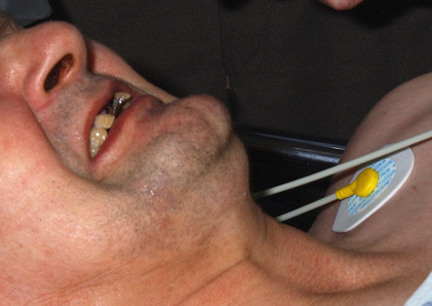Resumo
Definição
História e exame físico
Principais fatores diagnósticos
- lesão prévia propensa a tétano
- estado da imunização antitetânica
- trismo (mandíbula travada)
- dorsalgia
- rigidez/aumento do tônus muscular
- disfagia
- espasmos
Outros fatores diagnósticos
- usuários de drogas injetáveis
- dificuldade respiratória
- pressão arterial, frequência de pulso e temperatura instáveis
- sudorese
Fatores de risco
- imunização antitetânica incompleta
- lesão
- práticas obstétricas assépticas
- usuários de drogas injetáveis
- injeção intramuscular sem assepsia
- cirurgia abdominal
- acupuntura, piercing de orelha, pedicuro, palitos de dente
- tumores necróticos
- infecção da orelha média
Investigações diagnósticas
Investigações a serem consideradas
- diagnóstico clínico
- toxina sérica
- detecção do Clostridium tetani a partir do tecido da ferida ou swab
- anticorpos séricos antitoxina
- esporos em amostras de drogas ou objetos relacionados a esta prática
- punção lombar
- eletroencefalograma
- eletromiografia
Algoritmo de tratamento
ferida limpa e pequena
ferida propensa a tétano
com tétano clínico
Colaboradores
Autores
Russell W. Steele, MD
Clinical Professor of Pediatrics
Tulane University School of Medicine
New Orleans
LA
Declarações
RWS declares that he has no competing interests.
Agradecimentos
Dr Russell W. Steele would like to gratefully acknowledge Dr Christopher M. Parry, Dr Nicholas J. Beeching, Dr Lucy E. Cottle, and Professor Enitan D. Carrol, the previous contributors to this topic.
Revisores
Louise Thwaites, BSc, MBBS, MD
Senior Clinical Research Fellow
Oxford University Clinical Research Unit
Hospital for Tropical Diseases
Ho Chi Minh City
Vietnam
Centre for Tropical Medicine and Global Health
Oxford University
Oxford, UK
Declarações
LT is an author of a number of references cited in this topic.
Katrina Kretsinger, MD, MA
Commander
U.S. Public Health Service
Medical Epidemiologist
HIV Vaccine Team
Epidemiology Branch
Division of HIV/AIDS Prevention
National Center for HIV/AIDS, Viral Hepatitis, STD, and TB Prevention
Centers for Disease Control and Prevention
Atlanta, GA
Declarações
KK declares that she has no competing interests.
Créditos aos pareceristas
Os tópicos do BMJ Best Practice são constantemente atualizados, seguindo os desenvolvimentos das evidências e das diretrizes. Os pareceristas aqui listados revisaram o conteúdo pelo menos uma vez durante a história do tópico.
Declarações
As afiliações e declarações dos pareceristas referem--se ao momento da revisão.
Referências
Principais artigos
UK Health Security Agency. Tetanus: the green book, chapter 30. Jun 2022 [internet publication].Texto completo
Centers for Disease Control and Prevention. Child and adolescent immunization schedule by age: recommendations for ages 18 years or younger, United States, 2025. Nov 2024 [internet publication].Texto completo
Centers for Disease Control and Prevention. Adult immunization schedule by age: recommendations for ages 19 years or older, United States, 2025. Nov 2024 [internet publication].Texto completo
Havers FP, Moro PL, Hunter P, et al. Use of tetanus toxoid, reduced diphtheria toxoid, and acellular pertussis vaccines: updated recommendations of the Advisory Committee on Immunization Practices - United States, 2019. MMWR Morb Mortal Wkly Rep. 2020 Jan 24;69(3):77-83.Texto completo Resumo
Tiwari TSP, Moro PL, Acosta AM. Tetanus. In: Hall E, Wodi AP, Hamborsky J, et al, eds. Centers for Disease Control and Prevention. Epidemiology and vaccine-preventable diseases. 14th ed. Washington, D.C.: Public Health Foundation; 2021.Texto completo
Artigos de referência
Uma lista completa das fontes referenciadas neste tópico está disponível para os usuários com acesso total ao BMJ Best Practice.

Diagnósticos diferenciais
- Distonias induzidas por medicamentos, por exemplo, fenotiazinas
- Intoxicação por estricnina
- Síndrome neuroléptica maligna
Mais Diagnósticos diferenciaisDiretrizes
- Child and adolescent immunization schedule by age: recommendations for ages 18 years or younger, United States, 2025
- Adult immunization schedule by age: recommendations for ages 19 years or older, United States, 2025
Mais DiretrizesFolhetos informativos para os pacientes
Vacina DTP (difteria, tétano, poliomielite)
Vacina DTPa (difteria, tétano, poliomielite e coqueluche)
Mais Folhetos informativos para os pacientesConectar-se ou assinar para acessar todo o BMJ Best Practice
O uso deste conteúdo está sujeito ao nosso aviso legal